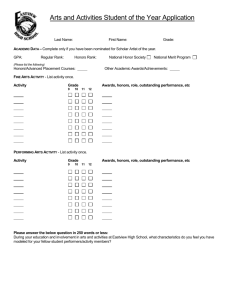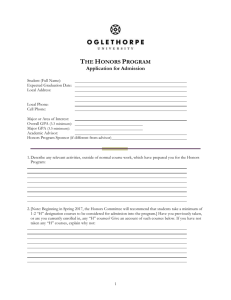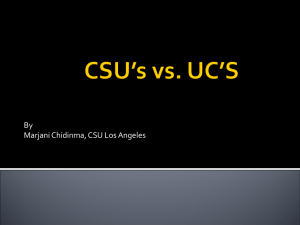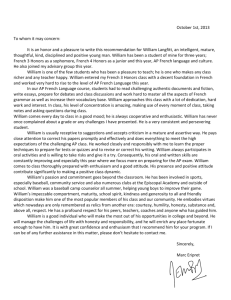CSU Admission Information
advertisement
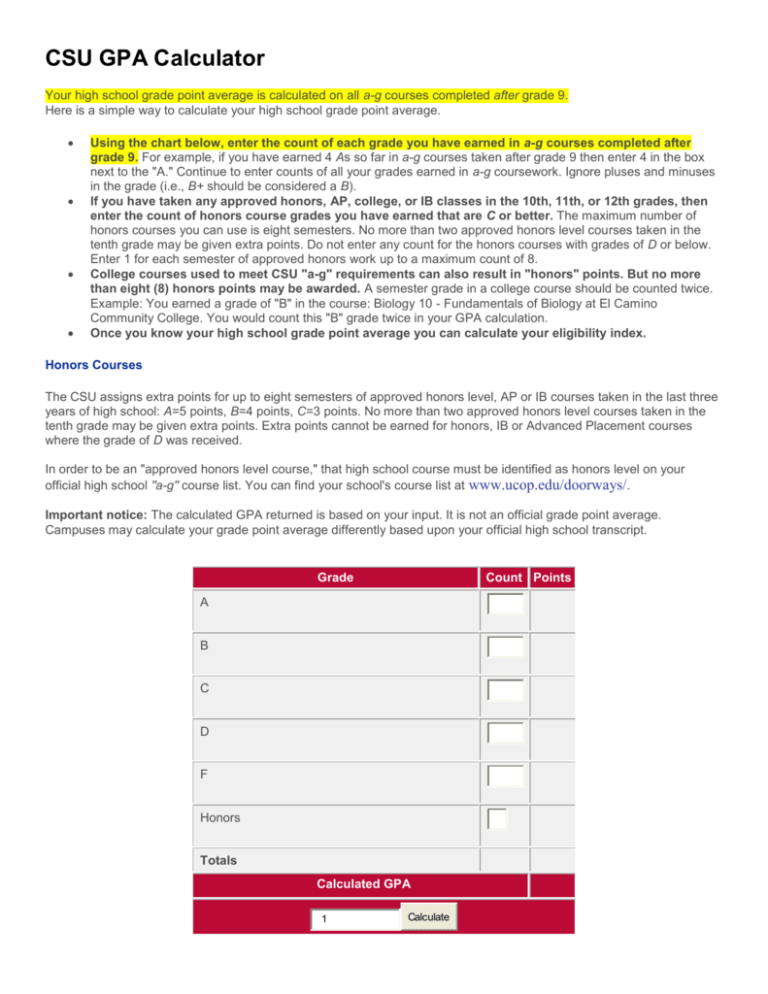
CSU GPA Calculator Your high school grade point average is calculated on all a-g courses completed after grade 9. Here is a simple way to calculate your high school grade point average. Using the chart below, enter the count of each grade you have earned in a-g courses completed after grade 9. For example, if you have earned 4 As so far in a-g courses taken after grade 9 then enter 4 in the box next to the "A." Continue to enter counts of all your grades earned in a-g coursework. Ignore pluses and minuses in the grade (i.e., B+ should be considered a B). If you have taken any approved honors, AP, college, or IB classes in the 10th, 11th, or 12th grades, then enter the count of honors course grades you have earned that are C or better. The maximum number of honors courses you can use is eight semesters. No more than two approved honors level courses taken in the tenth grade may be given extra points. Do not enter any count for the honors courses with grades of D or below. Enter 1 for each semester of approved honors work up to a maximum count of 8. College courses used to meet CSU "a-g" requirements can also result in "honors" points. But no more than eight (8) honors points may be awarded. A semester grade in a college course should be counted twice. Example: You earned a grade of "B" in the course: Biology 10 - Fundamentals of Biology at El Camino Community College. You would count this "B" grade twice in your GPA calculation. Once you know your high school grade point average you can calculate your eligibility index. Honors Courses The CSU assigns extra points for up to eight semesters of approved honors level, AP or IB courses taken in the last three years of high school: A=5 points, B=4 points, C=3 points. No more than two approved honors level courses taken in the tenth grade may be given extra points. Extra points cannot be earned for honors, IB or Advanced Placement courses where the grade of D was received. In order to be an "approved honors level course," that high school course must be identified as honors level on your official high school "a-g" course list. You can find your school's course list at www.ucop.edu/doorways/. Important notice: The calculated GPA returned is based on your input. It is not an official grade point average. Campuses may calculate your grade point average differently based upon your official high school transcript. Grade Count Points A Number of courses you received a grade of A: B Number of courses you received a grade of B: C Number of courses you received a grade of C: D Number of courses you received a grade of D: F Number of courses you received a grade of F: Honors Number of Honors Courses: Totals Calculated GPA 1 Calculate CSU - Calculate Your Eligibility Index Once you calculate your grade point average, you can use this formula to see if your grade point average and test scores meet the minimum required eligibility index. California residents (California high school graduate or a resident of California for tuition purposes) must have a minimum eligibility index of 2900 using SAT scores or 694 using ACT scores. (The SAT score component for CSU is the sum of the mathematics and critical reading scores. Neither ACT nor SAT writing scores are included in the calculation of the CSU Eligibility Index.) California nonresidents or nongraduates of California high schools must have a minimum eligibility index of 3502 using SAT scores or 842 using ACT scores. SAT Scores: ACT Scores: (Your GPA ) x 800 + Your SAT Total (Your GPA ) x 200 + (10 x ACT Comp) >>> My index is ______ >>> My index is ______ If you apply for admission before you graduate from high school, you should compute your GPA using grades earned in "a-g" courses completed after the 9th grade. Do not include grades you expect to earn in courses you have not completed. High School Subject Requirements The CSU requires a minimum 15-unit pattern of courses for admission as a first-time freshman. Each unit is equal to a year of study in a subject area. A grade of C or better is required for each course you use to meet any subject requirement. Area Subject Years a. History and Social Science (including 1 year of U.S. history or 1 semester of U.S. history and 1 semester of civics or American government AND 1 year of social science) 2 b. English (4 years of college preparatory English composition and literature) 4 c. Math (4 years recommended) including Algebra I, Geometry, Algebra II, or higher mathematics (take one each year) 3 d. Laboratory Science (including 1 biological science and 1 physical science) 2 e. Language Other than English (2 years of the same language; American Sign Language is applicable - See below about a possible waiver of this requirement) 2 f. Visual and Performing Arts (dance, drama or theater, music, or visual art) 1 g. College Preparatory Elective (additional year chosen from the University of California "a-g" list) 1 Total Required Courses 15 There are career and technical education (CTE) courses that can be used to meet any of the subject area requirements listed above. Please refer to www.ucop.edu/doorways for the entire listing of approved courses. Waiver of "Language Other than English" Requirement If you can demonstrate competency in a language other than English that is equivalent to or higher than that expected of students who have completed two years of language other than English study, you may be allowed a waiver for this language requirement. For further information, contact the CSU campuses to which you are applying. Impacted Programs - Supplementary Admission Criteria In the California State University, an undergraduate major or campus is designated as impacted when the number of CSU eligible applications received in the initial filing period (October 1 to November 30 for fall admission) is greater than the number that can be accommodated by the major or campus. In such instances, CSU campuses have been authorized to use supplementary admission criteria to screen applicants to these majors and/or campuses. These supplementary admission criteria may include, but are not limited to the following: Cease accepting admission applications at the conclusion of the initial filing period; Require submission of the SAT or ACT regardless of the high school grade point average; Rank order first-time freshmen by eligibility index; Set a higher minimum eligibility index than that required for CSU admission; Review additional characteristics such as socioeconomic or educational factors, space availability in a program or major, indications of overcoming educational obstacles, or exceptional talents; and Require completion of specified lower-division general education requirements for transfer applicants. For more information about Impaction, please refer to: www.calstate.edu/impactioninfo.shtml.

